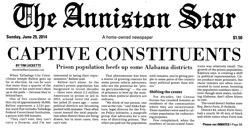Census’ prison population tabulation adds hurdles to redistricting in Alabama
Article explores prison gerrymandering in Alabama, highlighting problems in creating equal representation in city council wards and state legislative districts.
by Aleks Kajstura, July 1, 2014
The Anniston Star recently published a great article by Tim Lockette: Captive constituents: Prison population beefs up some Alabama districts.
Lockette explores how the Census Bureau’s decision to tabulate incarcerated people at the location of the correctional facilities impacts redistricting in Alabama:
When Talladega City Councilman Joseph Ballow goes up for re-election, he can be sure that more than a quarter of the residents in his ward won’t show up at the polls — because they’re behind bars.
One of five councilmen in this city of approximately 16,000, Ballow represents a 3,121-person ward that includes Talladega Federal Correctional Institution, a prison with 939 inmates.
“They can’t vote, they can’t carry a firearm, and I’m not interested in being their representative,” Ballow said.
Bellow’s attitude toward the folks incarcerated in his district is not unique, and it’s consistent with state law that says incarcerated people remain residents of their home address, and therefore constituents of the representatives of their home communities.
City and state officials say Talladega politicians typically see the prison as a burden.
“The question has always been, ‘Do we have to take it?,'” said Dawn Landholm, principal planner for the East Alabama Regional Planning and Development Commission, which has drawn district lines for many local cities, including Talladega’s ward lines after the 2000 Census.
Landholm said council members tend to feel cheated if they get a district that doesn’t include lots of actual registered voters. Council members have often asked if they can count only the voting-age population in drawing districts, she said.
“We’ve had to tell them they can’t just draw the district around voters,” Landholm said. “You have to take everybody.”
I agree with Landholm, districts should be based on actual population. And that means Talladega can follow the lead of over 200 local governments across the country that successfully avoid prison gerrymandering by removing the out-of-town-resident incarcerated population from their redistricting data. In fact it looks like some folks in town are already thinking about it:
Talladega City Manager Brian Muenger said he’s heard of other cities that discount the inmate population when drawing districts. He said he’d be open to proposing a similar option for Talladega.
The problem extends far beyond Talladega’s city wards. Prison gerrymandering impacts state legislative districts as well because the state replies on the same flawed Census data for redistricting:
The architect of Alabama’s post-2010 redistricting plan, Sen. Gerald Dial, R-Lineville, said the state did the best it could with the numbers it has.
Fair redistricting is hard enough without incarcerated populations being tabulated in the wrong place, so ideally the Census Bureau would change where it counts incarcerated people and provide states with redistricting data that reflects people at their actual home address. But in the meantime cities such as Talladega can adjust their redistricting data to exclude incarcerated populations, and Alabama can join California, Delaware, Maryland and New York by passing state-wide legislation to count people at home for redistricting purposes.





The best solution is to allow prisoners to vote.
Letting incarcerated people vote would be a good idea, but it’s a separate problem. If incarcerated people in Alabama could vote, they’d be required to vote via absentee ballot in their home districts; so we’d still have the problem of prison gerrymandering.